By 2006, the Disney Animation Studios had collected a number of projects in various stages of development, including ideas that had been lingering around for decades, somehow never quite managing to take the next step into development stage. One of many such projects was a little thing about a video game—something Disney storyboard artists had worked on back in the 1980s, and then again in the 1990s, going nowhere until John Lasseter, Disney’s then-new Chief Creative Officer, hearing the magic words “video game,” thought of bringing up the concept to veteran television animation director Rich Moore.
Spoilers ahead.
Lasseter had loved Moore’s work on Fox shows such as Futurama and The Simpsons, and thought that Moore could bring a needed comic touch to the Disney studio. Moore, feeling considerably less enthusiastic about the idea, initially disagreed. As he later explained in various interviews, in his mind, video game characters were static and unchanging, trapped in the same plot over and over, giving him little to work with. (You can all fill in your own jokes about The Simpsons here.) But then again, Moore thought, perhaps that could be the point of the film: a story about a character trapped in a video game who didn’t want to be there, and started to rebel. He pitched that concept to Lasseter, who loved it. Three more writers and storyboard artists, Phil Johnston, Jennifer Lee and Jim Reardon (another Simpsons veteran, who had also scripted and done storyboard supervision for Pixar’s Wall-E) were called in to work on the film.
Like most Disney films, Wreck-It Ralph was originally supposed to focus on the hero, Fix-It Felix, Jr., a cheerful character who ran around, well, fixing things. The problem was, as Moore quickly realized, Fix-It Felix was considerably less interesting than his opponent, Wreck-It Ralph. After some more brainstorming, the film’s concept shifted yet again: this time focusing on bad guy Wreck-It Ralph, who regularly attends support groups for video game villains (led by Clyde, aka the Orange Ghost in Pac-Man), and yet continues to want to be something else, a hero.
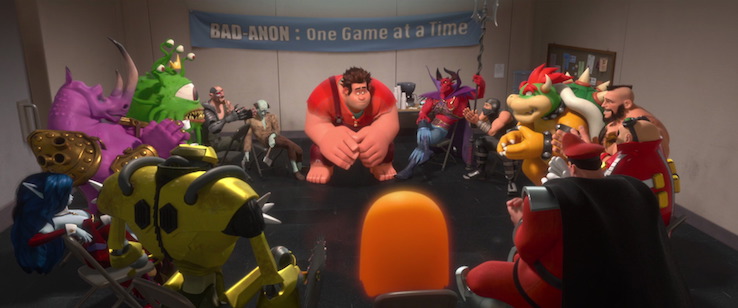
Becoming a hero in his own game is an impossibility—not just because it would wreck his game, but because the other characters in his game can’t even conceive of the possibility. Indeed, they won’t even invite him to their parties. In a sign that deep down, these supposedly good characters have just a touch of villainy themselves, they continually treat him as the bad guy and make him live and sleep in an uncomfortable dump just outside of the nice building with its penthouse apartments that he wrecks every time someone puts a quarter into the machine. So, storyboard artists and animators decided to come up with another world where Ralph could—maybe—win a medal and become, at long last, a good guy.
In the end, Disney animators created not just one more world, but four, for a total of five: three worlds based on video games, one world connecting them, and the video game arcade that contains them all. The design work for each world is often brilliant: the background and characters of the Fix-It-Felix game, for instance, not only have a genuine look reminiscent of Donkey Kong and other 8 bit characters, the minor characters all move, just a little, like those characters, even when they aren’t in “game mode.” They don’t look completely like 8 bit characters—Disney tried that, and found that even they could not make 8 bit characters sympathetic and lovable—but they came close.
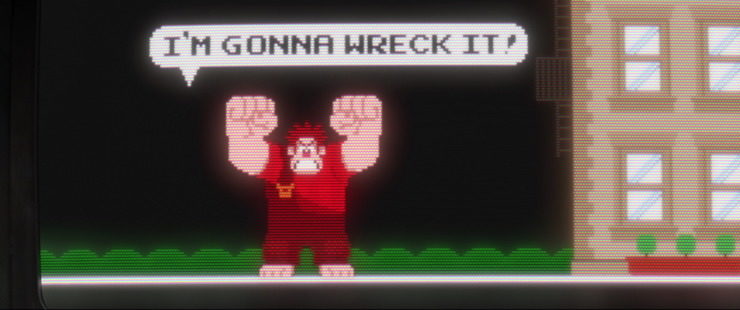
Also brilliantly done: the world for Hero’s Duty, loosely inspired by the Halo and Call of Duty first shooter games. Hero’s Duty both mocks that genre, providing a hilariously over the top backstory for chief character Sergeant Calhoun, and embraces it, showing a beautifully detailed apocalyptic world where weddings can get interrupted by giant bugs at any point, sending programmed video characters into a killing rage. Also brilliant, in a completely different sense of the word: the world of Sugar Rush, a hyper bright colorful world of candy and cookies and Nesquik and Coke and other sweet things. It’s not quite as well thought out as the other worlds, but it’s certainly eye-popping.
And of course, Game Central Station, the place that links the different video games together, a place that can only be reached by traveling through surge protectors. Naturally.
I should perhaps point out here that I’m not much of a video game player, and wasn’t even back in the Atari days, mostly because we didn’t have an Atari, so I only played that at other people’s houses. So some of Game Central Station was somewhat lost on me, but it’s not too hard to recognize Sonic the Hedgehog and the poor little characters from Q*Bert, now homeless and desperate for food, any food, as well as a few characters from Pixar films and Tangled sneaking around in the background.
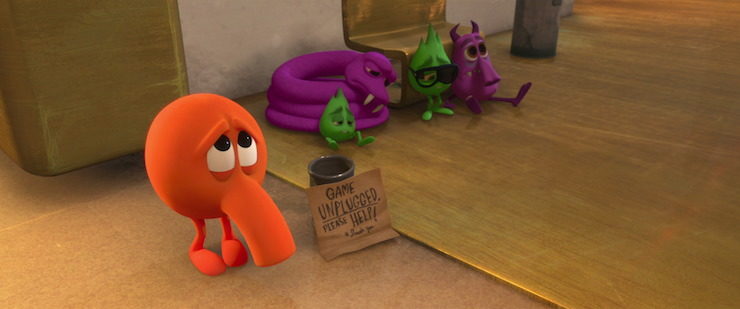
Not being able to recognize the classic video game characters also doesn’t matter much, since—with the exception of Q-Bert and, somewhat surprisingly, Root Beer Tapper, the bartender from Tapper, not exactly one of the more well-known video game characters out there—none of these characters get to be more than cameos, even the poor video game villains attending their weekly support group. Even, come to think of it, Root Beer Tapper, who just gets a moment of listening to Ralph’s troubles. As cool as Game Central Station is, and as much as it might be worth exploring, the film mostly stays with its original characters.
Which is perhaps just as well, since if the film spent too much time at Game Central Station, viewers might start asking some pointed questions. Like, given that the film emphasizes that all of these characters and their video game worlds are created from computer code, who coded Game Central Station? And why? And, after a character used Grand Central Station to nearly destroy all video game worlds, why wasn’t the place just abandoned? Did the coders fear that without an escape, video game characters would fall into abject despair, crawl to the corners of their screens, and refuse to move? And since that escape is available, why isn’t Ralph spending his nights at Game Central Station and related areas, instead of on uncomfortable bricks in his own game world? Does Game Central Station have any apartments for rent for minor characters, like the ones in Fix-It Felix, whose games have been/are about to be terminated, or are all of those characters doomed to become sad, hopeless and homeless characters hanging out against a wall, holding out little tin cans for a single bit of computer code to give them an energy buzz? Is Pac-Man never tempted to just give up this life of eating bland dots and the occasional bunch of cherries for a life of chugging down root beer instead? We do see him, after all, at a dance party over at Fix-It Felix’s penthouse home. It seems quite possible that in between dots, Pac-Man longs for freedom.
Speaking of that party: Ralph’s breaking moment, it seems, isn’t just the realization that he’s stuck in the role of a villain, but that the other characters in his game don’t even have the basic decency to send him an invite to their 30th anniversary celebration. Though perhaps, given that they’ve forcing him to sleep on a garbage dump for years, he should have seen that coming. Still, for the rest of the film, I couldn’t help thinking that if the Fix-It Felix characters hadn’t been COMPLETE JERKS unable to follow basic kindergarten standards like INVITE EVERYONE TO THE PARTY AND GIVE EVERYONE IN YOUR CLASS A VALENTINE EVEN IF YOU DON’T WANT TO SO THAT THEY DON’T FEEL LEFT OUT, THEY WOULD HAVE SAVED SEVERAL THOUSAND VIDEO GAME CHARACTERS A LOT OF GRIEF.
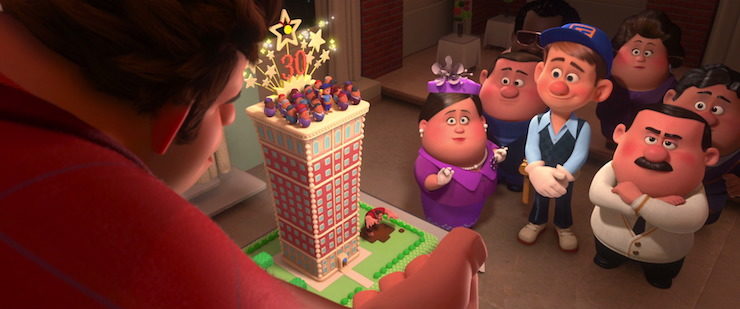
Because as it turns out, jumping in and out of different video games is the very opposite of not safe. After claiming his medal, Ralph accidentally brings a bug from Hero’s Duty along with him, which, as it reproduces, is capable of destroying the entire world of Sugar Rush, something that might be a bigger deal if the film didn’t largely drop this plotline for several minutes before suddenly remembering, in between all of the sugar jokes and bonding and plotting that oh, right, yes, ALSO THIS GAME IS ABOUT TO BE EATEN.
Ok, sure, eventually this leads to good things for the Sugar Rush crowd, who unknowingly are dealing with BETRAYAL and CODE CHANGES and SUGARY BEHIND THE SCENES DEALS, but before that, nearly all of the Sugar Rush characters are threatened with NEAR CERTAIN DOOM, and it’s a safe bet that their frantic rush to Game Central Station at the very least inconvenienced quite a few characters and trampled some others, although at least Wreck-It Ralph does let us know that all of the poor little Q*Bert characters are ok and not squished.
Still, I’d also like to know why, exactly, not one person in the film—including the generally kindly Fix-It Felix—realizes that all of this could have been avoided if only the characters had been gracious enough to invite Ralph to their celebration party. But no. Instead, the Fix-It Felix characters continue to ostracize and blame Ralph for everything, including their upcoming demise, right up until Ralph attempts to sacrifice himself to save Sugar Rush. And even then, I didn’t hear an apology, or an acknowledgement that they screwed up, though to be fair, they do finally have the grace to be friendly to Ralph at last, even when that “at last” means “after Ralph has saved another video game world, introduced Felix to the love of his life, and made Fix-It Felix a popular retro game saving you all from termination so, you know, basic friendliness is about the least you can offer him just now.”
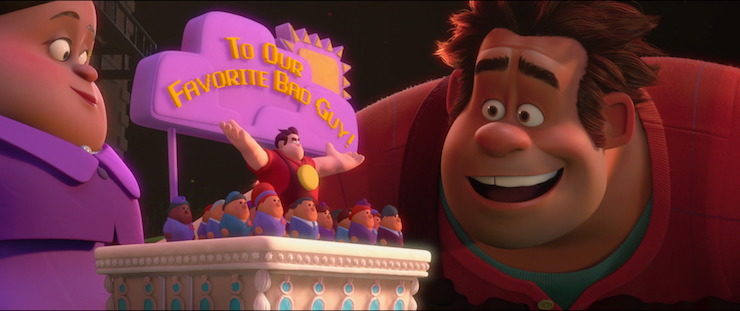
The Pac-Man ghosts are more friendly and helpful. I’m just saying.
The minor characters of Fix-It Felix are hardly the only mean and unthinking characters in the various video games, of course. The villains, as they explain, have to be villains and evil and do bad things, but quite a few non-villain characters in Sugar Rush have also developed a mean streak, despite living lives surrounded by candy and chocolate. To be fair, this is partly because Sinister Things are going on, and because they have—they think—legitimate concerns with the object of their scorn and hatred, Vanellope von Schweetz, voiced charmingly by Sarah Silverman. She is, as both the dialogue and animation make clear, a “glitch,” something wrong, a character whose animation continually flickers. King Candy encourages the other characters to ostracize her and keep her out of the races, for, King Candy claims, the good of the game: she’s, well, different, and if she races, as a glitch, she’ll destroy the game and everyone in it.
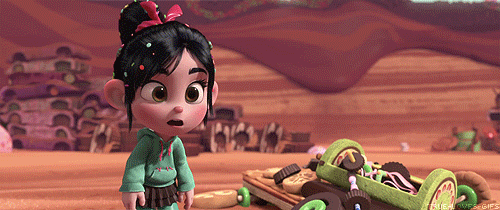
As it turns out—spoiler—this is not exactly true, but rather something invented by King Candy to ensure that he, a character who is also from another game, can retain power in Sugar Rush. Which turns what could have been a merely fluffy story about video game characters trying to change their destinies into a powerful example of how prejudice can be used by people in power to retain that power, a theme that would become an increasing focus of Disney films in the Lasseter era.
In this context, it’s important to note that Ralph, the other villains, and Vanellope aren’t just outsiders: they are programmed to be different. Changing what they are, as the villains, Tapper, and Vanellope point out, is impossible. The villains will always be villains (even Ralph), Tapper will always serve root beer, and Vanellope will always be a glitch.
Changing what they do, however—well, that might be possible.
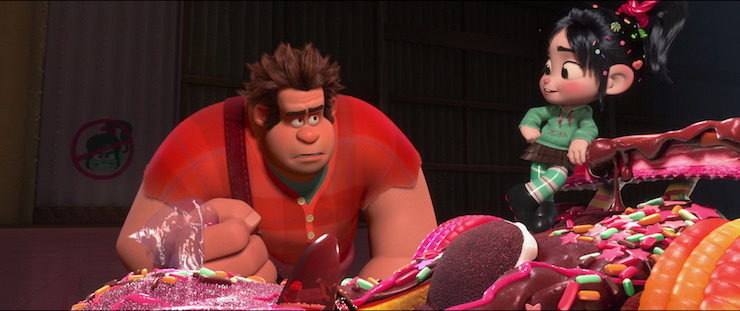
Might. Ralph, at least, thinks so. But notably, his first attempt to be a hero also nearly gets everyone in Sugar Rush killed. His later attempt to do the right thing—keep Vanellope from racing, since if she does race, Sugar Rush will be destroyed—is, as Vanellope notes bitterly, not exactly heroic, and, because Ralph isn’t all that insightful, also something that feeds right into the real villain’s plans. Even his last act of genuine heroism doesn’t transform him into a hero: the final scenes show him right back at the villains support group, in between smashing things. What is does do is finally get him some actual friends—and better living conditions.
So it’s not entirely a waste—but it’s also illustrative of the limits of what can be changed, a major change for a studio whose most famous films had focused on completely transforming who and even what you are. Thus, Pinocchio changes from a puppet to a real boy; Ariel changes from a mermaid to a human; the Beast changes to a prince. Rapunzel leaves her tower and becomes a princess—losing her magic in the process. It’s not universal—Simba remains a lion, although he changes from a helpless, guilty little lion cub to a powerful adult lion who realizes he did not kill his father, and Cinderella only changes her dress, not her humanity. But it’s a central part of the Disney mythos developed in film after film after film: try hard enough, wish hard enough, find a little magic—and you can escape. You can change. You can—if you are in Peter Pan—even fly.
Wreck-it Ralph challenges that view, not just by showcasing characters who are fundamentally unable to change themselves, but by showing—and admitting—that even trying to make these changes is not a simple thing, and by having Vanellope, in the end, reject her transformation to princess status. In some ways, this makes Wreck-It Ralph one of Disney’s most subversive films ever, in the sense that it is one of the few Disney animated films to challenge the company line (Frozen, Zootopia and to a certain extent, Moana would go right back to embracing it). In other ways, Wreck-It Ralph’s insistence that no, you can’t change your fate or your place in life or what you were meant to do, although you can tweak those elements to find happiness, makes it one of Disney’s least subversive films ever.

Not entirely incidentally, all the issues gnawing away at Sugar Rush and Fix-It Felix end up making Hero’s Duty—the violent, first person shooter game—the most ethical, honest and kindly video game of the group, oddly enough. I say “oddly,” since the idea that a violent world can produce honesty and heroism, while a seemingly simplistic world produces bitterness and dissatisfaction and a sugary sweet world cannot be trusted—Well. It’s an interesting message from a Disney film. The Disney films had often studied issues of appearances and trust, of course—this was the central theme of most of the Disney Renaissance films—but the concept of justice and protection coming from a dark, violent world fighting injustice instead of from the cheery rulers of a bright, sugary, seemingly safe place strikes me as something different, something more than the earlier looks at this in the 1990s.
One other thing makes Wreck-It Ralph stand out from its predecessors and most of the films that followed it: product placement. This was something hardly new to Wreck-It Ralph, of course—and in a sense, every Disney film since Fantasia, created in part to help sell more Mickey Mouse hats, and absolutely every Disney film since the opening of Disneyland in 1955 (that is, Sleeping Beauty and later), has more or less been all about product placement—to the point where one Disney film, Hercules, even mocked Disney’s—can I say obsession? Maybe method is the better word here—with marketing toys and other related film projects. Sure, an occasional film or two not created with the secondary purpose of selling toys slipped through kinda by accident, and one or two films had made joking references to other consumer products, but for the most part, the Disney films have been aggressive marketing tools for Disney products, not other brands.
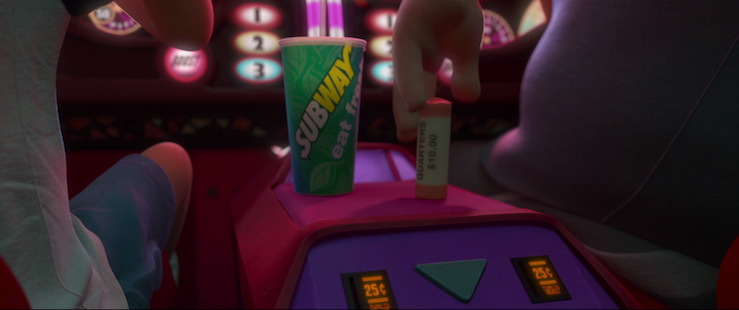
Wreck-It-Ralph, however, takes a drastic change here, featuring multiple product placements for non-Disney brand items. Even apart from the expected references to various video games—an inevitability in any film focused on video games—Wreck-It Ralph contains a prominent visual of a Subway drink, and prominent references to various candies and other sugary products, including a donut called Dunkin, an eclair called Winchell, and some Oreos cosplaying as soldiers from The Wizard of Oz. (I laughed.) Quite a lot of this—like the Mentos and the Diet Coke—is played for laughs, but one moment—again, the Mentos and the Diet Coke—is a major plot point, making Wreck-It Ralph the only Disney film I can think of that relies on product placement to save the day.
Irritated sidenote: Given the age of most of the video games in the film, those should be Wintergreen Life Savers, not Mentos, which is what we used back in my day—the same day where we played games that looked just like Fix-It Felix—to pull off that stunt. They exploded JUST FINE, thank you very much, and also, I am not old. Just old enough to remember when Atari was exciting and new and Wintergreen Lifesavers were the way to explode things.
Using product placement in this way feels rather less like Disney, and more like, well, Pixar. Which leads me right to the observation, made by many others before me: Wreck-It Ralph feels more like a Pixar film than a Disney film—and not just because of the product placement, either. Its study of a possible world hidden behind our world, and its insistence that otherwise inanimate objects have a life of their own when not beneath human gazes (or, I guess, surveillance cameras) is pure Pixar. It’s perhaps not a coincidence that the product placement issue would also appear, to a lesser extent, in another “Pixar-like” Disney film, Zootopia.
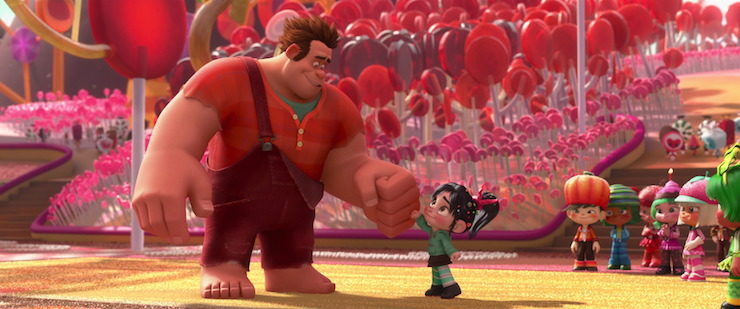
At least some of this, of course, was because of John Lasseter’s takeover of the studio. Some was thanks to the heavy involvement of former Pixar storyboard supervisor Jim Reardon—even if Reardon had been brought on board more for his work on The Simpsons than for his recent Pixar experience. And some of this, and not just the shot of the Subway cup—just reflected the realities of filmmaking. Even with computer assistance, animation was still expensive.
That Pixar feel, of course, didn’t preclude Wreck-It Ralph from pursuing some of the standard Disney themes, including, as I noted, the concept of the differences between outside appearances and reality, or the outsider who just wants to belong—here seen in two different characters, Ralph and Vanellope. And the Pixar touch did not mean that Wreck-It Ralph inherited all of the Pixar strengths. The Pixar films, for instance, are notable in part for maintaining a tight story focus, something Wreck-It Ralph, probably because of last minute rewrites and concept changes and multiple writers and storyboard artists, doesn’t really have. Oh, it has plenty of plot, but midway through the film, the focus switches from Ralph’s story to Vanellope’s story, when remembering that oh, yes, it also has this little sidestory about some incoming invading aliens to deal with, not to mention the love story between Sergeant Calhoun and Fix-It Felix, which I would criticize for having pretty much zilch to do with the rest of the plot and for bringing up a major plot hole in the last five minutes if it wasn’t such a fun little side romance.
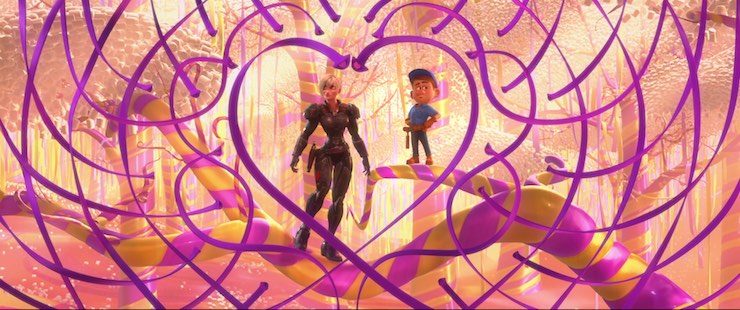
I should mention one more thing: the voicing, which, as standard for Disney films, runs from serviceable (most of the minor characters and Jack McBreyer as Fix-It Felix) to perhaps overly recognizable (Jane Lynch, pretty much playing Jane Lynch as Sergeant Calhoun, and Sarah Silverman as Vanellope) to outstanding (John C. Reilly as Ralph), to the start of something major—Alan Tudyk as King Candy.
Tudyk, probably best known on this site for his work on Firefly and Serenity, had previously voiced a number of roles for various television cartoon shows, ranging from Batman: The Brave and the Bold to Family Guy, but Wreck-It Ralph was the start of what would be a long and lucrative collaboration. Tudyk would continue from this role to voice parts in Frozen, Big Hero 6, Zootopia and Moana; hopeful fan rumors claim that he will be making a cameo appearance in Wreck-It Ralph 2 and have a role in Gigantic.
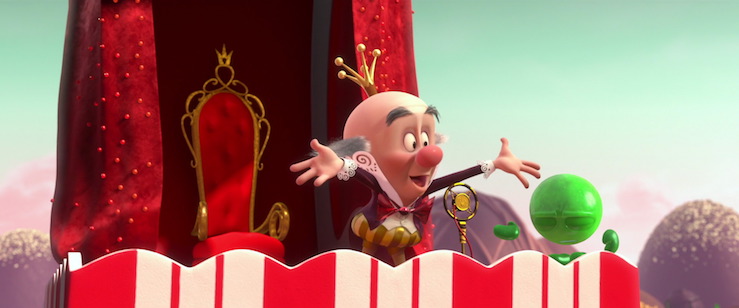
Wreck-it Ralph was a success not just for Tudyk, but also for Disney, bringing in $471.2 million at the box office. That wasn’t quite enough to greenlight a park attraction, but it was enough for Disney to put a sequel into production—this time, a sequel currently scheduled for a full theatrical release in 2018, not just home video. Disney also released the standard merchandise of clothing, mugs, mousepads, figurines and Disney Trading Pins, many still available throughout the parks and in online stores. And, naturally, Disney released multiple tie-in games for various video platforms, and added Ralph and Vanellope to Disney Infinity.
It was another strong sign that the animation studio, after starting off the century in more than a bit of a slump, was on its road to recovery. The question was: could that recovery be sustained? Even with—gasp—other films not focused on Disney Princesses?
Zootopia, coming up next.
Mari Ness lives in central Florida.










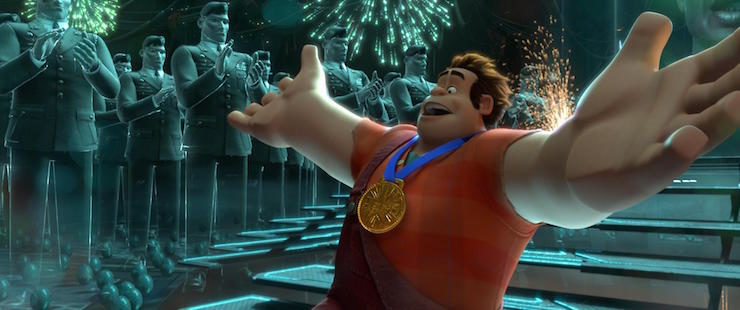
I think the relative lack of dysfunction in Hero’s Duty might have had more to do with it being a new game than anything else. The characters haven’t had time to develop much personality beyond their core programming. The stress of being in a violent game might cause more NPCs to break like the soldier in Tappers.
“And, naturally, Disney released multiple tie-in games for various video platforms”
Including an actual arcade cabinet of Fix-it Felix Jr., because Disney is wonderful. It may have also helped them get a more realistic faux-8-Bit look. There were at least a dozen of them in Disney Quest when I was there a few years ago, I wonder what’s become of them now? Best concept art ever?
– Jade Phoenix – Although DisneyQuest is scheduled to close “soon,” as of today it’s still open, so I’m assuming the arcade cabinets are still there right now. They’ll presumably be shifted over to one of the resorts once DisneyQuest starts its transformation into the NBA Experience.
Tudyk also does voice work for Disney’s Star vs. the Forces of Evil.
I was the only one in the entire theater to laugh at the shot of graffiti proclaiming “Aerith Lives!!” and it saddened me greatly.
The first trailer for Wreck-it Ralph will stay in my memory forever as the first time I have been physically attracted to a cartoon character. Ralph is a hottie.
I had no idea that was Alan Tudyk voicing King Candy. Mind blown.
While I thoroughly enjoyed Wreck-it-Ralph, I managed to discern the true nature of King Candy pretty quickly in the film.
They actually created another video game world, called Extreme EZ Livin’ 2 (it’s like The Sims meets Grand Theft Auto), which is featured in a deleted scene (all of which are totally worth watching).
Don’t forget that Game Central Station also includes Tiny from Meet the Robinsons (and a game called… Tron?), as well as a missing dog poster featuring Bolt and the invoice from Paperman both pinned to the board in the Bad Anon meeting.
I feel that Tudyk will become to Disney animations what Ratzenberger is to Pixar.
“That wasn’t quite enough to greenlight a park attraction…”
Well, depending on the current rumors, maybe it was. (Though the sequel probably has as much to do with that possibility.)
I’m not much into video games, and didn’t watch this. But starve it, I want a film all about Pac-Man. *looks on TV Tropes* Holy Carp, there have been two TV shows all about Pac-Man and Co. This pleases me immensely.
Sugar Rush is quite a new game, though — the movie opens with it just being installed. So Mentos and Diet Coke is appropriate for the time it was coded.
@10: I was going to say just that.
Wreck-it Ralph is one of my favorites of the newer Disney animated films. I laughed out loud the first time I saw it. In fact, when Disney’s Decendants first premiered, my brother wanted me to tape record it (we didn’t have a DVR then) so that he could watch it later (he was busy that day). It turned out that Wreck-it Ralph was on right before the premiere of Decendants, so I taped that too, and that’s the movie I was watching for a week afterwards.
This one is almost on my list of sick-day-feel-good films. I say “almost” because I have to cringe and look away when Ralph tries to join the party. Poor Ralph. But overall, the theme of “You can’t always get what you want, but if you try, sometimes you’ll find that you get what you need” is uplifting.
The visuals are absolutely fabulous, especially for Sugar Rush. I’m sure it comes as a surprise to no one that at one point there was a tabletop diorama made entirely of sweets for the animators to study.
Oh, and there’s an explanation for Game Central Station: It’s what happens when you connect games to a surge protector and never turn them off. Probably the personification of the surge protector designed and built the place to bring some order to game characters just running around willy-nilly.
Also, here’s possibly the best piece of Wreck-It Ralph fanfic ever written:
https://archiveofourown.org/works/694808
“Local Man Finds His Arcade ‘Turbotastic’ ” by cadavatar.
What CapnAndy and poohfan95 said. Sugar Rush is supposed to be a newer game. It’s also supposed to be Japanese or Japanese influenced? They got J-Pop supergroup AKB48 to do the theme song, to sorta give that feel of the latest greatest kawaiiest thing from overseas.
My main memory of Wreck It Ralph was that it was the first movie I saw when I got home from working in Japan for a year. In Tokyo, AKB48 had been a terrifying omnipresence wherever you turned. So I recognized them instantly when the Sugar Rush theme started playing. My sister in the next seat was VERY confused when I put my head in my hands and started muttering “I can never get away. I can NEVER GET AWAY…”
… S-U, G-A-R, jump into your racing car…
So anyway, yes, really the problem with the mentos and coke is that really it should have been whatever the Japanese equivalent is. Though I suppose their version of the game could have been localized for American release.
“…not to mention the love story between Sergeant Calhoun and Fix-It Felix, which I would criticize for having pretty much zilch to do with the rest of the plot and for bringing up a major plot hole in the last five minutes if it wasn’t such a fun little side romance.”
Forgive me, but bringing up what major plot hole? I must have missed something.
Terngirl – The plot hole: Showing Vanellope the Glitch over in Hero’s Duty,as a bridesmaid at the wedding of Calhoun and Fix-It Felix. Except – Vanellope’s a glitch who can’t possibly leave Sugar Rush. The film spent some considerable time telling us this. Plot hole.
If anyone’s ever played Mario Kart 8, be sure to race a track called Sweet Sweet Canyon. Visually, it’s 100% based on the Sugar Rush track from the film, right down to the use of bright pink colors.
@15 – I’m confused. Wasn’t her code restored at the end? It was King Candy who made her a glitch.
@@@@@ MariCats – but Vanellope wasn’t a glitch, she was the main character of the game & her code had been damaged by King Candy/Turbo. Once the game was reset, her code was restored. I would say the plot hole would be more that she was able to keep her ‘glitch’ powers after the restoration.
Austin – The end of the film also specifically shows her still using her glitch form in order to win races in Sugar Rush, so, yeah, she’s still a glitch.
The cybug plotline is not abandoned. No zombie movie starts at the beginning of the zombie invasion, because killing one zombie would be very easy; similarly, the cybugs wouldn’t have been interesting until they were a full-fledged invasion. Showing them regularly eating stuff in Sugar Rush to remind us they’re here wouldn’t have been interesting, unless they were going to eat characters, and that would have been very dark.
I don’t understand how they can justify having lots of retro characters spontaneously appearing in Fix-it Felix Jr. with using the words “Easter eggs”. And Vanellope is cheated. I’m sure the people who choose her are the same who play the sorcerer in Dark Souls.
@15: Vanellope’s status after the end of the movie is not clear: she is an official character from the game again, but she still has glitch powers. It’s possible that she would have to cancel her glitch powers to get out, but as the queen, she can easily access the game code (using the Konami code, of course) to reactivate her glitch powers. As I said, she’s a cheat.
Based on similar concepts, I recommend the Captain SNES webcomic.
@19: I always figured that she wasn’t a glitch anymore, but that because she had been a glitch before she just “remembered” how to glitch around in her game, and that’s why she was still glitching at the end of the movie.
It never even occurred to me that it might be a plot hole. I just took it for granted.
“But then again, Moore thought, perhaps that could be the point of the film: a story about a character trapped in a video game who didn’t want to be there, and started to rebel.”
So Westworld the movie inspired Wreck-It Ralph which then re-inspired a new generation to make the TV show? q;o)
(Just some fun sarcasm)
Honestly, the plot hole isn’t Vanellope leaving her game after she’s restored, as she’s no longer a glitch, but her retaining her teleporting glitch during races.
I dunno, either she deliberately went back and re-added those powers to herself because she liked them, or the Vanellope racer was always supposed to have a teleport special ability in the original game code and everyone (including her) was just making wrong assumptions about why she could do that because they thought she was a glitch. Pick whichever helps you sleep better at night.
@6 Tudyk’s voice-characterization for King Candy sounds to me like an uncannily brilliant channeling of Ed Wynn’s voicing of the Mad Hatter in Disney’s ALICE IN WONDERLAND, another shout-out to classic Disney features.
Mention must be made that in today’s Wall Street Journal, there is an article about Alan Tudyk’s voice work for Disney.
Vanellope’s “glitch” power is actually her special power. Each racer has a special power that they can use during races. For example, Rancis Fluggerbutter ( the one with a Reese’s cup on his head) can pour oil on the track. Not a glitch.
@26: Oh okay. So she was supposed to be able to that then. I guess the only way she was a glitch was that she was temporarily a beta element. (I guess her time as a beta element also made her special power a bit unpredictable in the process).
I missed this movie in the theaters, but at my son’s insistence, watched it when it came on cable, and I was quite pleased. It had the feel of a Disney movie, but enough subversion of the standard tropes that I felt like I was watching something fresh and new. And John C. Reilly was just great as Ralph, and from interviews I have seen later, had a lot of fun playing the character, with a joy that infuses the performance. In fact, Mr. Reilly is great in just about every role he plays.
I could not believe how good the movie was – I actually saw it while I was bored and didn’t really know anything “about” the movie beforehand (something impossible with these “franchise” movies now). It’s not just that it was funny, but it was so well thought out and put together.
Even the soundtrack was great!
“when did video games become so violent?!”
Generally, I don’t enjoy John C. Reillys work. Not that I hate him or anything, he just doesn’t really make me laugh the way he does most folks. This, though, is a brilliant turn, and a great piece of acting that I really loved.
Kind of like Brad Pitt and Will Ferrel in Megamind. Usually, I find them kind of predictable, and dull, but in that, they both were amazing.
There’s something special about animation that really lets an actor go places they don’t usually get to.
I utterly love this movie. This is probably in my top 10, maybe even my top 5 (my top rated non-musical for sure). I think – as trivial and even under developed as it is, in some ways – Calhoun and Felix are probably my favorite Disney couple. Maybe because in some ways they remind me a lot of my husband and me (except my husband is very tall and I am very short…personality wise though…the shoe kinda fits, he). I guess I just love pairings of hypercompetent women with men who are perfectly able to handle that and secure in their own selves (in other words, not just being overwhelmed by the force of personality or insecure or what have you). And this is perhaps a trivial and silly example of it, but I love it anyway. I also love all of Calhoun’s sayings “A cautionary dog chasing a mangy tail” (and Felix’s responses…I know, right?). Hah.
My oldest son also loves this movie. We went on a road trip to Wyoming this summer which involved LOTS of driving. Despite having several movies at our disposal, it was mostly Wreck-It Ralph (I am pretty sure one day we watched it 4 times, and several other days at least once a day). And here’s the thing – neither me nor my husband got sick of it. In fact, after our trip we sat down to watch it so we could actually WATCH the movie instead of listen to it. Although I will say that listening to it gave me a great appreciation for the sound design and voice talents (especially Alan Tudyk who does an amazing ‘Mad Hatter’ impression here), and the Sugar Rush song :)
Two things I think that really sell this movie for me:
One, I love the twist regarding Turbo/King Candy and the way it is set up is really great/tight storytelling, in my opinion. The Turbo story has its reason for being told, even if there was nothing else to come out of it, and fits totally naturally into the movie. There’s some foreshadowing already (especially if you’re canny enough to recognize the voice) but even some of King Candy’s responses to Ralph or his fears of going Turbo really fit with the truth. Even his explanation for why Vanellope can’t race makes sense on the surface. However, unless you’re really savvy, it comes a great twist when you see that he is actually Turbo. It’s a great twist – it’s surprising/shocking (at least it was to me, heh), but also makes perfect sense once you actually look back at it. It feels earned, not like it was just thrown in to come out of nowhere.
I also really love the part at the end where Ralph is willing to accept who he is and sacrifice himself…and then Vanelope comes in to save him at the last minute (also embracing her own glitch powers). The first time my son was watching this he just flipped out; he was on the edge of his seat for the movie and then whe Vannelope saved the day he got so excited I thought he might actually start crying for a second. I can’t say I was quote so overwrought with emotion when I saw the movie but for a 4-5 year old, it was a pretty good eucastrophe.
There’s a lot about this film I liked, but I struggled with it because I found Vanellope incredibly irritating. And I say that as someone who pretty much never finds characters irritating and has no problem with Sarah Silverman normally. Something about the combination of the voice acting and the dialogue drove me completely up the wall. That said, I have only seen it once when it was first released and I really feel like giving it another go.
Wreck-it Ralph is the best Oz movie of the 21st century.
@20:
mmmmm…. A disney Dark Souls movie, how about that?